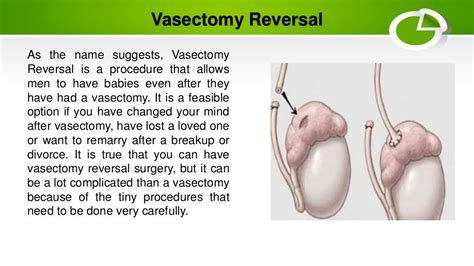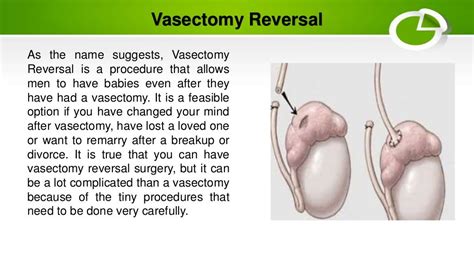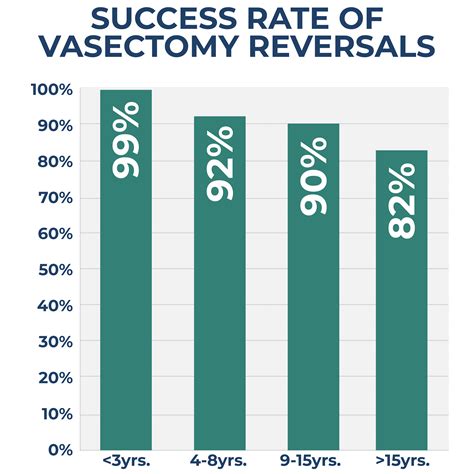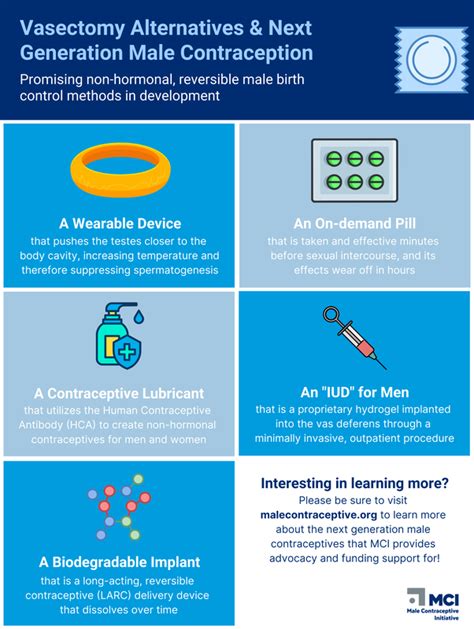Intro
Learn about reversing vasectomy with a vasectomy reversal procedure, also known as vasovasostomy, to restore fertility and overcome male infertility issues.
The decision to undergo a vasectomy is a significant one, and for many men, it provides a reliable and permanent form of birth control. However, life circumstances can change, and some men may find themselves wanting to reverse the procedure. This can be due to a variety of reasons, such as a change in marital status, a desire for more children, or simply a reevaluation of their initial decision. Whatever the reason, it's essential to understand the process, benefits, and potential outcomes of undoing a vasectomy.
For men who have undergone a vasectomy, the possibility of reversing the procedure can offer a new lease on their reproductive life. The reversal process, known as a vasectomy reversal, is a surgical procedure that aims to restore the flow of sperm through the vas deferens, the tube that carries sperm from the testicles to the penis. This procedure can be complex, and its success depends on various factors, including the length of time since the original vasectomy, the age of the patient, and the overall health of the reproductive system.
The importance of understanding the vasectomy reversal process cannot be overstated. It's a significant decision that requires careful consideration and consultation with a healthcare professional. The procedure itself is typically performed under local or general anesthesia and involves making an incision in the scrotum to access the vas deferens. The surgeon then carefully reconnects the severed ends of the vas deferens, allowing sperm to flow through once again. The success of the procedure is often measured by the return of sperm to the semen, which can take several months to a year or more after the reversal.
Understanding Vasectomy Reversal

Understanding the intricacies of vasectomy reversal is crucial for anyone considering the procedure. The first step is to consult with a urologist or a healthcare provider who specializes in reproductive health. They will assess the individual's overall health, discuss the potential risks and benefits, and explain the procedure in detail. It's also essential to have realistic expectations about the outcome, as the success of the reversal can vary depending on several factors.
One of the critical factors influencing the success of a vasectomy reversal is the time elapsed since the original procedure. Generally, the sooner the reversal is performed after the vasectomy, the higher the chances of success. This is because, over time, the body may develop additional blockages or scar tissue that can complicate the reversal process. However, even after many years, reversal can still be successful, albeit with potentially lower success rates.
Benefits of Vasectomy Reversal
The benefits of vasectomy reversal are multifaceted. For many couples, the ability to conceive naturally again can be a significant advantage, allowing them to expand their family as desired. Additionally, the procedure can also help in restoring the natural flow of sperm, which some men may find preferable to other forms of fertility treatment. The psychological impact of regaining fertility should not be underestimated, as it can significantly affect a man's sense of well-being and identity.Steps Involved in Vasectomy Reversal

The steps involved in a vasectomy reversal are intricate and require precision. The procedure typically begins with the administration of anesthesia to ensure the patient's comfort during the surgery. The surgeon then makes a small incision in the scrotum to locate the vas deferens. Once the ends of the vas deferens are identified, the surgeon carefully removes any blockages or scar tissue that may have formed since the vasectomy.
The next step involves reconnecting the severed ends of the vas deferens. This is a delicate process that requires great skill, as the tubes are extremely small. The surgeon may use a microscope to assist in the procedure, allowing for more precise suturing of the vas deferens. The goal is to create a watertight seal that will allow sperm to flow through unimpeded.
Risks and Complications
As with any surgical procedure, there are risks and potential complications associated with vasectomy reversal. These can include infection, bleeding, and reactions to the anesthesia. Additionally, there is also a risk of fluid accumulation or hematoma at the surgical site. However, these complications are relatively rare and can often be managed with appropriate medical care.One of the more significant concerns for men undergoing vasectomy reversal is the potential for anti-sperm antibodies. These are immune system cells that may develop in response to the vasectomy and can attack sperm, reducing fertility even after a successful reversal. However, this complication can often be addressed through additional treatments or therapies.
Success Rates and Outcomes

The success rates of vasectomy reversal can vary significantly depending on several factors, including the time since the vasectomy, the age of the patient, and the surgical technique used. Generally, the sooner the reversal is performed after the vasectomy, the higher the chances of success. For men who undergo reversal within three years of their vasectomy, the success rate can be as high as 70% to 90%. However, this rate can decrease to around 30% for those who wait ten years or more after their vasectomy.
Success is typically measured by the return of sperm to the semen, which can be confirmed through a semen analysis. However, the presence of sperm does not guarantee fertility, as other factors such as sperm quality and the partner's fertility can also play a role. Couples may still need to undergo additional fertility treatments to achieve pregnancy.
Post-Operative Care and Recovery
Post-operative care and recovery are crucial components of the vasectomy reversal process. Immediately after the procedure, patients are advised to rest and avoid strenuous activities for several weeks. This allows the body to heal properly and reduces the risk of complications. Patients may experience some discomfort, swelling, or bruising in the scrotal area, which can be managed with pain medication and ice packs.It's also essential for patients to follow up with their healthcare provider as directed. This includes attending post-operative appointments to monitor the healing process and conducting semen analyses to check for the presence of sperm. These follow-ups are vital for assessing the success of the procedure and addressing any potential issues early on.
Alternatives to Vasectomy Reversal

For some men, vasectomy reversal may not be the best option, or it may not be successful. In such cases, there are alternative fertility treatments available. One common alternative is sperm retrieval combined with in vitro fertilization (IVF). This involves surgically retrieving sperm from the testicles or epididymis and then using these sperm to fertilize the partner's eggs in a laboratory. The resulting embryos are then transferred to the partner's uterus.
Another option is donor sperm insemination, where sperm from a donor is used to fertilize the partner's eggs. This can be a viable option for couples where the male partner's sperm is not viable or where vasectomy reversal is not successful. However, this option involves using sperm from an outside donor, which can raise ethical and emotional considerations for the couple.
Counseling and Support
The decision to undergo a vasectomy reversal, as well as the process itself, can be emotionally challenging for both the individual and their partner. It's essential to seek counseling and support to navigate these challenges. Many fertility clinics offer counseling services to help couples cope with the emotional aspects of fertility treatments. Support groups, either online or in-person, can also provide a valuable network of individuals and couples who are going through similar experiences.Conclusion and Next Steps

In conclusion, vasectomy reversal is a complex procedure that offers men the possibility of regaining their fertility. While it's a significant decision that requires careful consideration, the potential benefits can be life-changing for individuals and couples seeking to expand their family. It's crucial to approach this decision with a clear understanding of the process, potential outcomes, and alternatives.
For those considering vasectomy reversal, the next steps involve consulting with a healthcare provider to discuss the procedure in detail, including the potential risks, benefits, and success rates. It's also essential to have realistic expectations and to be prepared for the emotional and physical aspects of the journey.
Final Considerations
As with any significant medical decision, it's vital to weigh all the factors carefully. Vasectomy reversal is not just a medical procedure; it's a personal journey that can affect many aspects of one's life. By being informed, seeking support, and carefully considering all options, individuals can make the best decision for their unique circumstances.What is the success rate of vasectomy reversal?
+The success rate of vasectomy reversal can vary significantly depending on several factors, including the time since the vasectomy and the age of the patient. Generally, success rates can range from 30% to 90%.
How long does it take to recover from vasectomy reversal?
+Recovery from vasectomy reversal typically takes several weeks. Patients are advised to rest and avoid strenuous activities to allow the body to heal properly and reduce the risk of complications.
Are there alternatives to vasectomy reversal?
+Yes, there are alternatives to vasectomy reversal, including sperm retrieval combined with in vitro fertilization (IVF) and donor sperm insemination. These options can be viable for couples where vasectomy reversal is not successful or not desired.
We invite you to share your thoughts, experiences, or questions about vasectomy reversal in the comments below. Your input can help others who are considering this procedure, and together, we can build a supportive community that fosters understanding and knowledge. If you found this article informative, please consider sharing it with others who might benefit from this information.
